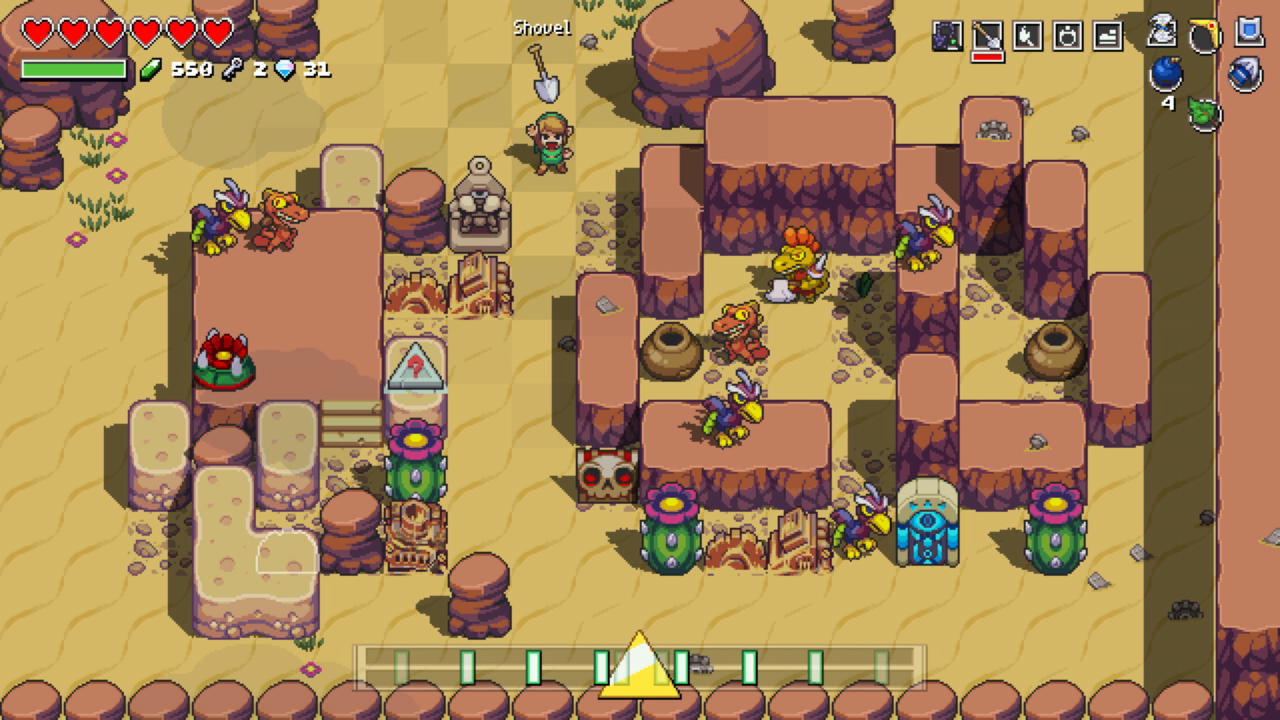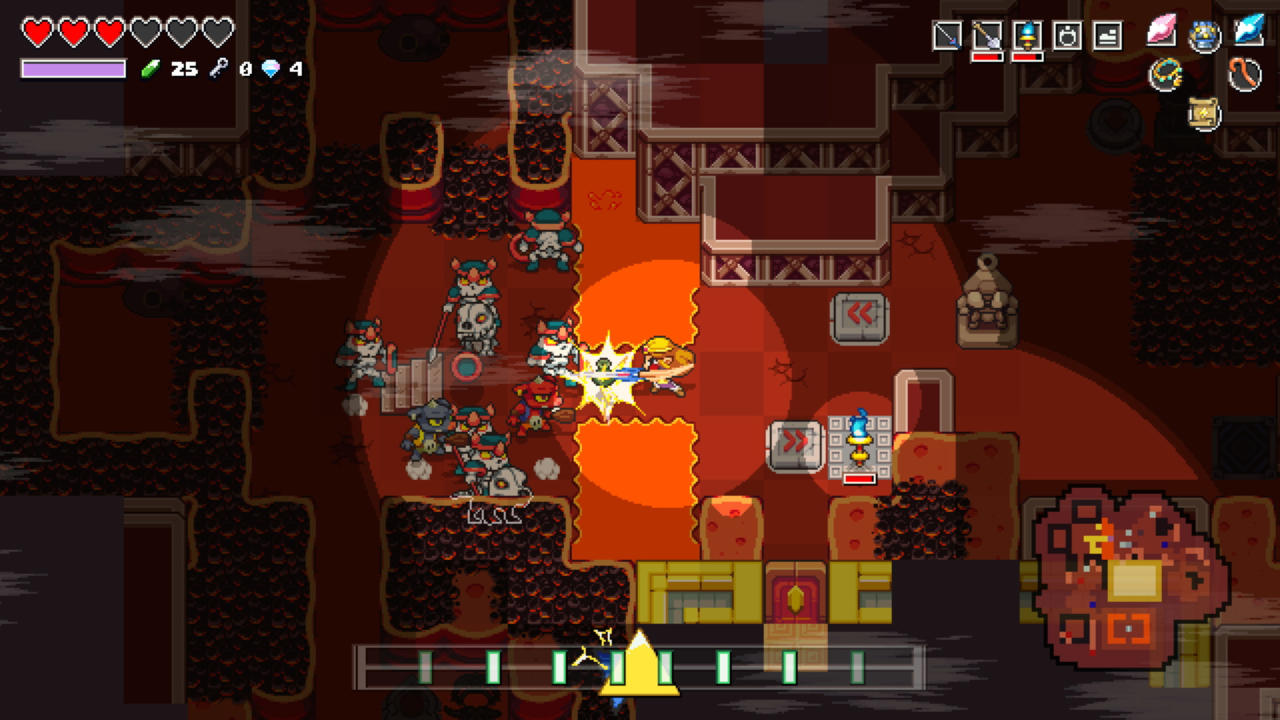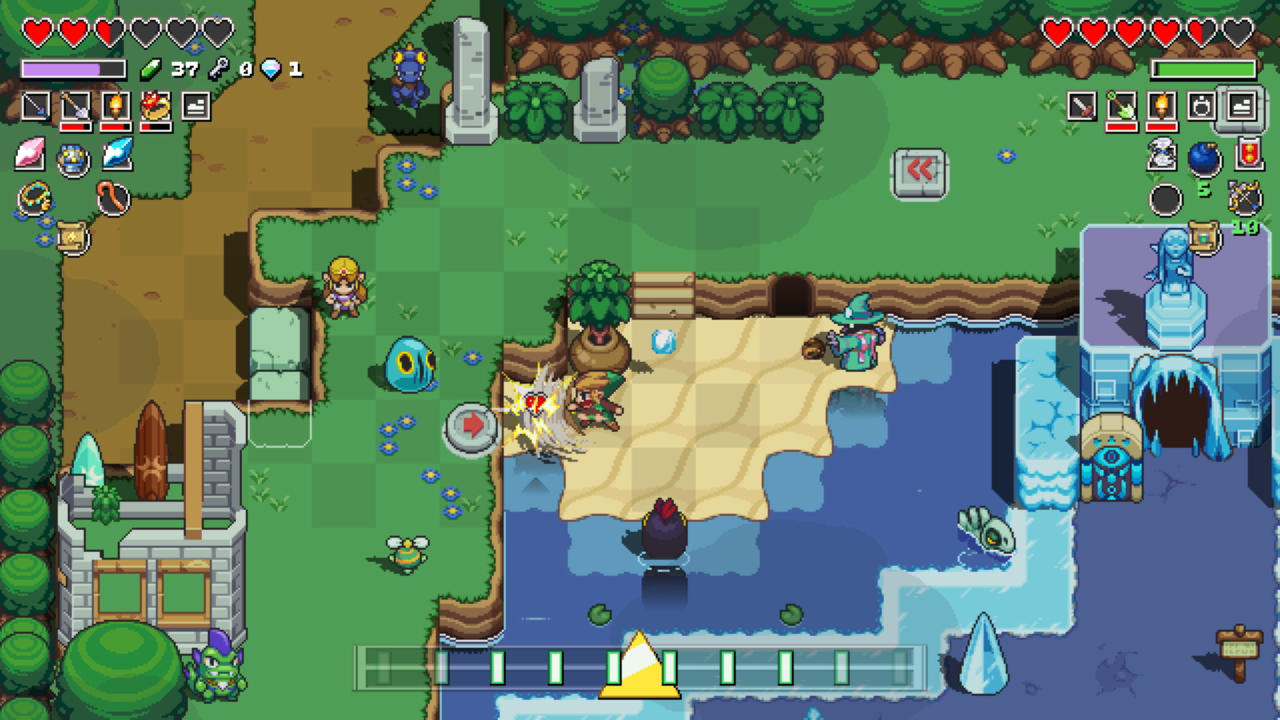The most surprising thing about Cadence of Hyrule, despite being so unusual, is how much it immediately feels like a Zelda game. Aesthetically, it sits somewhere between A Link to the Past and the cartoonier Four Swords games, but its Zelda roots run much deeper than that; This is not just Crypt of the NecroDancer reskinned. Much like The Legend of Zelda: A Link Between Worlds on 3DS, Cadence is a shorter, smaller riff on the classic 2D Zelda template with a unique twist, a game that will strike a chord with long-time fans but also feels fresh and exciting.
In the game's opening, Cadence (the protagonist of Crypt of the NecroDancer) is dropped into Hyrule by a mysterious vortex and must choose whether to awaken either Link or Zelda. From there, the game is pretty open--you explore a randomized overworld map in search of classic Zelda items and the four dungeons that need to be completed before you can storm Hyrule Castle, which has fallen to the game's big bad, the villainous musician Octavo. You'll eventually unlock both characters (and, potentially, two others), but being able to play as Zelda from the outset is wonderful and feels like a long-overdue correction of the series' namesake frequently being sidelined.
The game doesn't tell you exactly where to go at first, but thankfully the initial hour or two of simply moving between screens, uncovering your map and figuring out how your procedurally generated version of Hyrule fits together, is exhilarating. If there are monsters on the screen, you'll need to move in time with the beat of the game's music, indicated by marker at the bottom of your UI, timing your movements in four directions to avoid and attack enemies ripped from the Zelda universe. Each enemy has its own attack pattern and most have a clear "tell"--if a wolf looks like it's about to pounce, for instance, you'll want to make sure that you're not on the square in front of it on the next beat, whereas bigger enemies might have larger attack areas that will be marked on the ground one beat ahead of their assault. It's a system that the game frames as a "dance" between you and your enemies, and this is apt, as I would nearly always find myself bopping and tapping my foot alongside my movements.
Learning the rhythmic patterns of enemies, and reaching the point where you figure out how to best attack them so that you can properly counter-attack or defend yourself, is a consistent pleasure. When you slip into the zone and feel like your movements and steps are perfectly in sync with the rhythm and movements of your enemies, it's extremely satisfying, especially as you find new areas and monsters throughout the game and slowly conquer them. Coming back to an area you found intimidating early in the game and handily slaughtering all of the enemies, which causes the music to calm and loot to drop, feels fantastic.
Attacks and interactions are automatic depending on where you're standing, with each screen being divided into grid-based titles that you move between. There's an emphasis on being mindful of your movements and your surroundings on a beat-by-beat basis throughout the entire game, so it's handy that every song follows the same tempo--once you're tapped into it, your ability to move through the game is dependent on your ability to read the many different enemy animations and quickly plot out your movements on the fly. The only exceptions are certain hazards in the game world that slow or speed up the beat, and one inspired puzzle which asks you to step to the beat of a familiar piece of Zelda music.

The entire soundtrack is made up of beautifully reworked pieces from the Zelda series, with a number of tunes featuring as speedier, upbeat variations. They're all wonderful remixes of tracks that many players will already feel a strong attachment to, and the mostly consistent beat throughout the game keeps things manageable since you only really need to learn and become accustomed to one rhythm. There are plenty of fun aural Easter eggs for long-time Zelda fans, too. It's worth noting that there is also an accommodating accessibility option called "fixed beat" mode which stops enemies from moving unless you're moving, removing the need to follow the rhythm.
Cadence of Hyrule also has light roguelike elements, but it's a very generous system that encourages you to use your consumable items rather than stockpiling them. When you die, you lose any keys you've collected, all rupees, your shovel, your torch, and any stat-boosting items you've picked up. Your vital gear stays with you, though, as do all the weapons you've found. You won't need to do anything as drastic as finding your best sword or the hookshot again, which mitigates any frustration and keeps you focused on pushing forward.
Many of these classic Zelda items are hidden away in the overworld, but none of them are actually necessary to progress through the game. In fact, it's entirely possible to simply make a determined beeline towards each dungeon, and the game's timed leaderboards will likely entice many a speedrunner. For the rest of us, though, making the effort to find and use all the classic Zelda items will make the challenge easier, and going to the lengths to locate the items strewn throughout Hyrule is a hunt worth taking because simply playing the game is a joy in itself.

Cadence of Hyrule understands how much the pleasure of playing a Zelda game comes from the feeling that you're rising to the challenge of your environment, and after hours of learning and internalizing the rhythms of various enemy attacks, finding yourself less intimidated by all the creatures the game throws at you is a great feeling. Some items do end up feeling quite superfluous by virtue of not being necessary, however--I never once effectively used the boomerang, for instance, and even the bow (which can be equipped with numerous different types of arrows) feels inconsequential.
The dungeons are fun but short, requiring you to venture through randomly generated floors full of monsters and, eventually, combat musically-themed takes on classic Zelda bosses. These bosses all have wonderful designs that merge old favorites with new instrument-based powers, complete with genuinely funny pun names. There are very few puzzles in the game; the dungeons are entirely focused on combat and exploration. I found that the last two of the initial four in the overworld were extremely easy, as my version of Zelda had become quite powerful (I was on a long undying streak, equipped with some very useful buffs). But Cadence of Hyrule more than makes up for it with the challenge of the final trek through Hyrule Castle, which makes the extremely fun final boss battle, and the credits that roll after, feel well earned.
Once you're done, there are plenty of enticing reasons to come back, too. Hunting down every piece of treasure is a fun reason to spend more time exploring and fighting, and if you've found the right items the map will tell you exactly where unclaimed treasures are lying and let you warp around at your leisure, allowing you easily mop up any that you've missed. If you start again, the fact that the map randomizes each time means that you'll have a different experience, as areas will look different or have altered layouts.

There are also daily challenges, which plop you down at the beginning as either Link or Zelda and let you compete on a leaderboard to see how far you can get on a single life, as well as a permadeath mode. These modes are really just there for more avid players looking to master the game, but it's good to have the option. You can also play through the entire game in co-op, with one player taking control of Cadence while the other plays as Link or Zelda, which is a great addition. If one player dies you both go down, and if one of you moves to the next screen the other player will be warped there too, so working together to line up on the beat is important. The game works better as a single-player experience, but it's a nice choice to have.
Cadence of Hyrule is a fantastic Zelda game in its own right, even though it adopts the gameplay mechanics of another series. Beyond the aesthetics, it nails the satisfying sense of exploration and increasing power, and it revels in the joy of discovery, as all the best Zelda games do. It's an extremely successful melding of two great game series and an experience that makes you feel eager for Nintendo to do more interesting things with their major licenses.



















